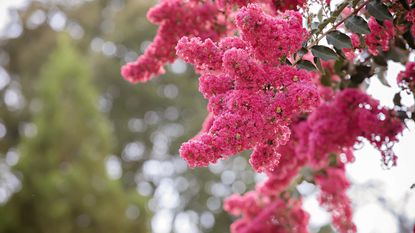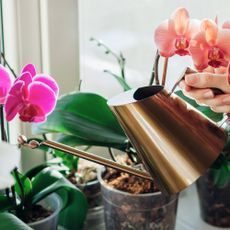Creating Contrast with Black Diamond Crape Myrtles


Showy blossoms, gorgeous bark and fall color send crape myrtle to the top of the list for satisfying shrubs for Southern backyards. The icing on the cake is how very little maintenance these plants require to froth over with colorful blooms all summer long. But if you want an edge up on the neighbors, take a peek at Black Diamond, a new series of crape myrtles, with star quality that will light up your garden with dramatic contrast.
Black Beauty
Black Diamond Blooms are the new kids on the block when it comes to amazing variations on the crape myrtle theme. This revolutionary new series of crape myrtles will delight your family and astonish your neighbors and guests. The foliage of these uniquely beautiful shrubs is black as black can be when it emerges in early spring. The flowers, on the other hand, sparkle with color, making you think of jewels displayed on black velvet. [caption id="attachment_21433" align="alignleft" width="400"]
Shell Pink Black Diamond[/caption] We aren't talking pastels here. These crepe myrtles start bright and move to brilliant. 'Shell Pink' blossoms glow in eye-catching coral, 'Crimson Red' offers blood red flowers with bright yellow centers, while 'Purely Purple' flowers are a vibrant shade you aren't likely to readily forget. And that's just for starters. You'll find lots of other shades from white ('Pure White') to lavender ('Lavender Lace'). Black Diamond crape myrtles thrive year round as trees/shrubs in USDA plant hardiness zones 7 through 10. And, in zone 6, you can typically grow them as perennials. They'll die back each fall but regrow in spring. The plants are treated as annuals in cooler regions falling below these zones.
Light Up Your Landscape
Planting Black Diamond crape myrtles is a sure way to light up your landscape, and there's no better way to do it. These shrubs are naturally compact, maxin g out at 12 feet (4 m.) tall and 8 feet (2.5 m.) wide. That opens up so many possibilities you may have trouble choosing one. [caption id="attachment_21434" align="alignright" width="400"]
Lavender Lace Black Diamond[/caption] One attractive use that gardeners love is to line a driveway, wall or fence with a row of these black-leaved crape myrtles. You won't even need to prune them back much, given their naturally short size, although they can be pruned to trees or shrubs for the landscape if desired. Compact shrubs, Black Diamonds also work well planted in decorative containers on a balcony or deck. They require little attention and are even drought tolerant in case you don't get around to irrigating as often as you would like. Pick a container color to match or contrast with the flowers. Despite their movie-star good looks, Black Diamonds are just as functional as other crape myrtle shrubs. If you need to install a hedge, why not consider Black Diamonds? You can't go wrong with striking crape myrtles like these for a compact, flowering privacy hedge, as beautiful from one side as the other. Plant them 3 feet (1 m.) apart and cut them back to 4 inches (10 cm.) in winter. They'll regrow to about 4 feet (1.2 m.) and flower profusely. It's easy to see why Black Diamond crape myrtles are so popular in the landscape. With their ease of care, short growing stature and dramatic color, these plants are certain to steal the show, making both them and you the stars of the neighborhood.
Gardening tips, videos, info and more delivered right to your inbox!
Sign up for the Gardening Know How newsletter today and receive a free download of our most popular eBook "How to Grow Delicious Tomatoes."

Teo Spengler has been gardening for 30 years. She is a docent at the San Francisco Botanical Garden. Her passion is trees, 250 of which she has planted on her land in France.
-
 How Often To Water Orchids – The Definitive Guide
How Often To Water Orchids – The Definitive GuideOrchids are too often victims of under and over-watering. Discover how often popular species need to be watered and the key signs to look for.
By Amy Grant
-
 5 Fast-Growing Intercrops To Max Out Your Vegetable Garden
5 Fast-Growing Intercrops To Max Out Your Vegetable GardenEven the smallest gardens can have mighty growing potential. These delicious intercrops are quick and easy to grow and will make your veg plot more productive.
By Amy Grant